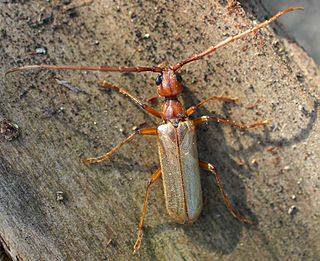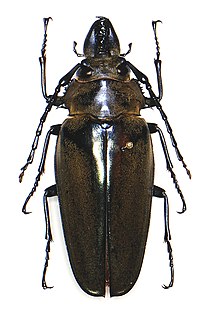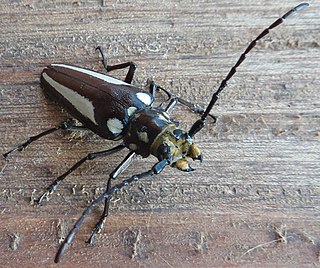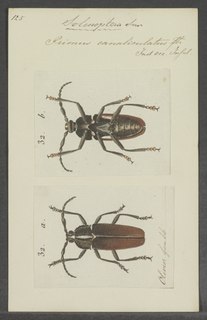
The longhorn beetles (Cerambycidae), also known as long-horned or longicorns, are a large family of beetles, with over 35,000 species described. Most species are characterized by extremely long antennae, which are often as long as or longer than the beetle's body. In various members of the family, however, the antennae are quite short and such species can be difficult to distinguish from related beetle families such as the Chrysomelidae. The scientific name of this beetle family goes back to a figure from Greek mythology: after an argument with nymphs, the shepherd Cerambus was transformed into a large beetle with horns.

The Chrysomeloidea are an enormous superfamily of beetles, with tens of thousands of species, mostly in the families Cerambycidae and Chrysomelidae, the leaf beetles.

Pallopteridae is a family of flies. The various species are collectively called flutter-wing flies, trembling-wing, or waving-wing flies, because of the striking vibration of the wings in many species. Over 70 species in about 15 genera are found in the temperate regions of the Northern and Southern Hemispheres.

Lamiinae, commonly called flat-faced longhorns, are a subfamily of the longhorn beetle family (Cerambycidae). The subfamily includes over 750 genera, rivaled in diversity within the family only by the subfamily Cerambycinae.

The Disteniidae are a small family of beetles in the superfamily Chrysomeloidea, traditionally treated as a group within the Cerambycidae.

The Oxypeltidae are a small family belonging to the superfamily Chrysomeloidea, widespread in the Andean region of Chile and Argentina. They have traditionally been considered a group within the Cerambycidae.

The Vesperidae are a small family of beetles, normally classified within the family Cerambycidae, of heterogeneous aspect but all characterised by larval stages related to roots of herbaceous plants or trees

Stephan von Breuning was an Austrian entomologist who specialised in the study of beetles (Coleopterology), particularly within the longhorn family (Cerambycidae).

The Trictenotomidae are a small family of beetles in the suborder Polyphaga containing fifteen species in two genera. Most species are found in the Oriental realm where they live in montane forest habitats. The family is considered, based on larval characters as well as sequence-based studies, to be closely related to the Salpingidae.

Callipogon is a genus of beetles belonging to the family Cerambycidae. Its closest relatives are the genera Enoplocerus, Ergates and Trichocnemis, with divergence from these lineages estimated to the Cretaceous about 80 million years ago. Most species are found in the Neotropics, with Callipogon relictus being the only palearctic species.

Solenoptera is a genus of beetles in the family Cerambycidae, subfamily Prioninae, and tribe Solenopterini. As of 2018, it contains the following species:
Argyrodines is a genus of beetles in the family Cerambycidae, containing the following species:

Trachyderini is a tribe of long-horned beetles in the family Cerambycidae. There are at least 140 genera and 650 described species in Trachyderini.
Cosmisoma compsoceroides is a species of beetle in the family Cerambycidae. It was described by Gounelle in 1911.
Dmytro Zajciw was a Ukrainian and Brazilian entomologist, notable for his collection and for his many beetle discoveries. He was born in Velyka Mykhailivka, Ukraine and died in Rio de Janeiro, Brasil. He was the author of Two new genera and species of neotropical Longhorn beetles , 1957, Contribution to the study of Longhorn beetles of Rio de Janeiro , 1958, and was the first to describe the genera Adesmoides and Pseudogrammopsis, as well as the species Beraba angusticollis and Mionochroma subaurosum, among many others.
Estola crassepunctata is a species of beetle in the family Cerambycidae. It was described by Stephan von Breuning in 1940. It is known from Brazil and French Guiana.
Estola dilloni is a species of beetle in the family Cerambycidae. It was described by Zayas in 1975. It is known from Cuba.
Paraepepeotes guttatus is a species of beetle in the family Cerambycidae. It was described by Félix Édouard Guérin-Méneville in 1844, originally under the genus Monohammus. It is known from India and China.

Paraepepeotes togatus is a species of beetle in the family Cerambycidae. It was described by Perroud in 1855, originally under the genus Monohammus. It is known from Papua New Guinea, Australia, and Moluccas.

Hammatoderus confusor is a species of beetle in the family Cerambycidae. It was described by Dillon and Dillon in 1941. Its Geographical distribution is Brazil, Peru, Bolivia, Paraguay, Colombia and Argentina (Misiones).













